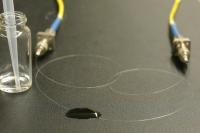Nano-layer optical fibre sensors for safety
Nano-layer sensors for immediate detection of biological or chemical hazards are an important step towards understanding environmental engineering problems. Most importantly, however, they will help to protect the life and health of people and animals.
The technology is researched by a team led by Mateusz Śmietana, Ph.D., D.Sc., from the WUT Institute of Microelectronics and Optoelectronics. They aim at development of the technology and then production and characterisation of modern optical fibre sensor structures with resistant thin-layer covers. Along with civilisation changes, there is a growing demand for sensors that can quickly detect biological or chemical hazards, or defects of building materials.
The structures are expected to have high sensitivity and reliability, ability to work in adverse conditions, response selectivity to the studied parameter and multiplication of the measurement point.
Optical fibres are not just light, compact and safe for the user. Light transmission in the optical fibre is insensitive to electromagnetic field interference, which is especially important in the industrial environment. To obtain nano-layers, researchers use the methods of chemical and physical deposition from the gaseous phase. This allows to obtain thin, optically transparent covers.
In 2011, the project “Nano-layer optical fibre sensors for liquid biodiagnostics” led by Mateusz Śmietana, Ph.D., D.Sc., was awarded a grant in the programme Leader of the National Centre for Research and Development. The competition winner was given 896,500 PLN for his research.








